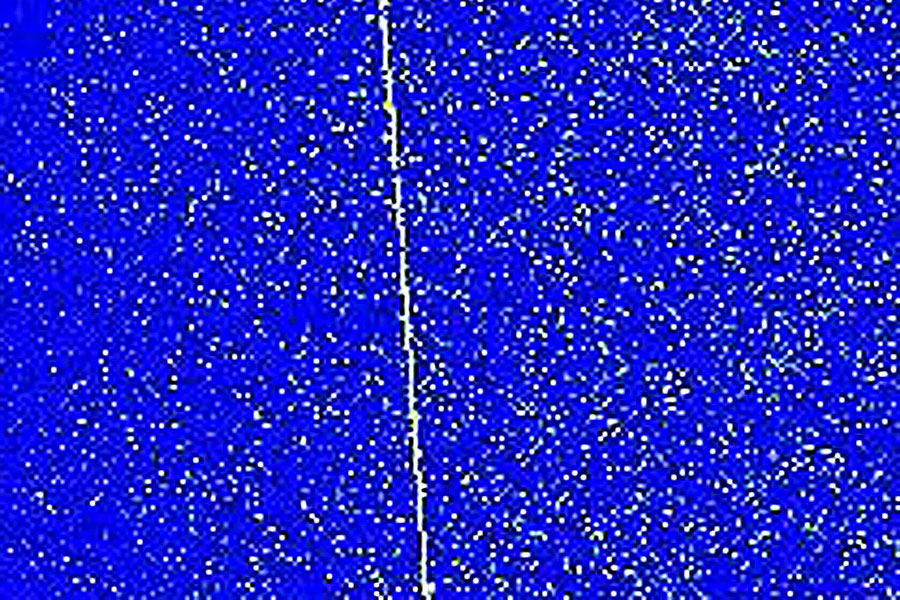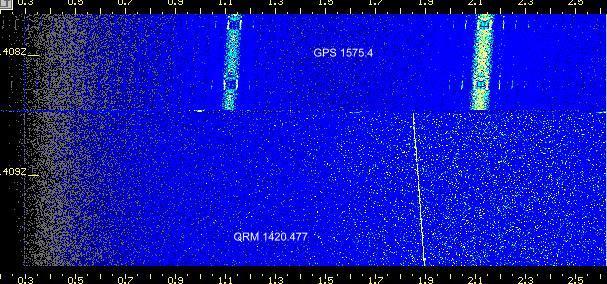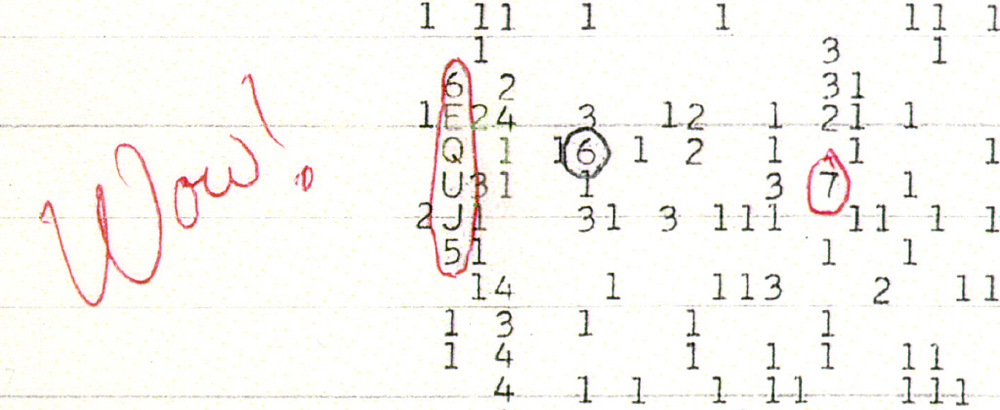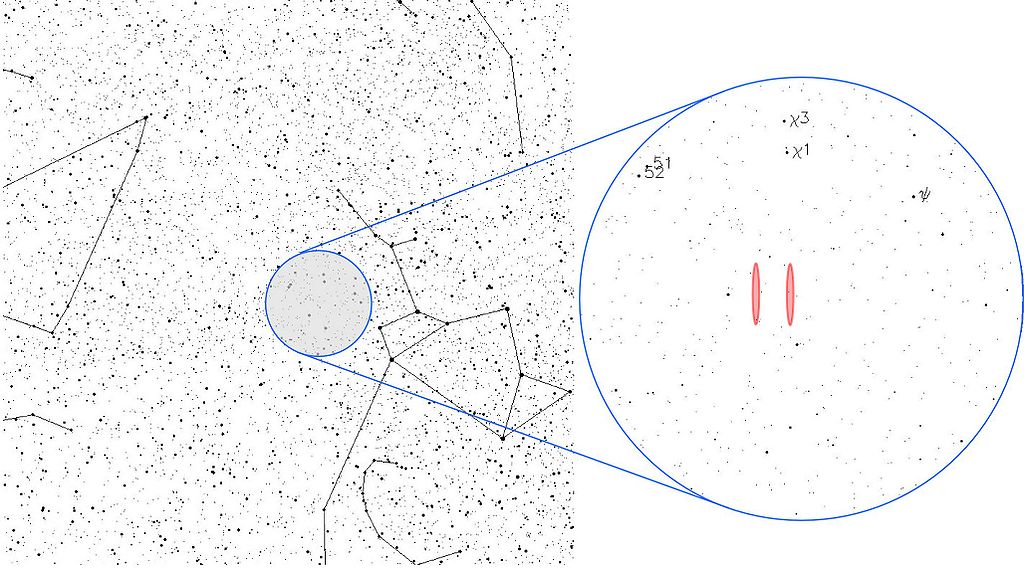|
|
|
| The
WOW Signal Wow! signal: The Wow! signal was a
strong narrowband radio signal detected by Jerry
R. Ehman on August 15, 1977, while he was working
on a SETI project at the Big Ear radio telescope
of The Ohio State University, then located at Ohio
Wesleyan University's Perkins Observatory in
Delaware, Ohio. The signal bore the expected
hallmarks of non-terrestrial and non-Solar System
origin. The signal appears to have come from the
northwest of the globular cluster of M55 in the
constellation Sagittarius, near the Chi Sagittarii
star group.
Source:
WikipediaThe entire signal sequence lasted for the full 72-second window that Big Ear was able to observe it, but has not been detected again. The signal has been the subject of significant media attention, and astronomers have tried many times in vain to find the signal again. Impressed by the relative resemblance of the expected signature of an interstellar signal in the antenna used, Ehman circled the signal on the computer printout and wrote the comment "Wow!" on its side, which became the name of the signal itself. Background The Wow! signal was detected by Jerry R. Ehman on August 15, 1977, who was working on a SETI project at now-defunct the Big Ear radio telescope of The Ohio State University. The telescope was then located at Ohio Wesleyan University's Perkins Observatory in Delaware, Ohio, when Ehman spotted a surprising vertical column with the alphanumerical sequence “6EQUJ5,” which had occurred at 10:16 p.m. EST. He took a red marker to write "Wow!" in the margin of the printout and encircled the alphanumeric code "6EQUJ5". Interpretation of the paper chart The circled alphanumeric code "6EQUJ5" describes the intensity variation of the signal. Each character represents 12 seconds (by 10 kHz). A space denotes an intensity between 0 and 1, the numbers 1 to 9 denote the correspondingly numbered intensities (from 1.0 to 9.9), and intensities of 10.0 and above are denoted by a letter ('A' corresponds to intensities between 10.0 and 11.0, 'B' to 11.0 to 12.0, etc.). The value 'U' (an intensity between 30.0 and 31.0) was the highest detected by the radio telescope; on a linear scale it was over 30 times louder than normal deep space. The intensity in this case is the unitless signal-to-noise ratio, where noise was averaged for that band over the previous few minutes. Two different values for its frequency have been given: 1420.356 MHz (J. D. Kraus) and 1420.4556 MHz (J. R. Ehman). The frequency of the Wow! signal matches very closely with the hydrogen line, which is at 1420.40575177 MHz. The hydrogen line frequency is significant for SETI searchers because, it is reasoned, hydrogen is the most common element in the universe, and hydrogen resonates at about 1420.40575177 MHz, so extraterrestrials might use that frequency to transmit a strong signal. The two different values given for the frequency of the Wow! signal (1420.356 MHz and 1420.4556 MHz) are the same distance apart from the hydrogen line—the first being about 0.0498 MHz (49.75177 kHz) less than the hydrogen line, and the second about 0.0498 MHz (49.84823 kHz) more. The bandwidth of the signal is less than 10 kHz (each column on the printout corresponds to a 10 kHz-wide channel; the signal is present in only one column). The location of the signal in the constellation Sagittarius, near the Chi Sagittarii star group. Because of the design of the experiment, the location may lie in either one of the two red bands, and there is also significant uncertainty in the declination (vertical axis). For clarity, the widths of the red bands are not drawn to scale; they should actually be narrower. The original printout of the Wow! signal, complete with Jerry Ehman's famous exclamation, is preserved by the Ohio Historical Society. Location of the signal Determining a precise location in the sky was complicated by the Big Ear telescope's use of two feed horns to search for signals, each pointing to a slightly different direction in the sky following Earth's rotation; the Wow! signal was detected in one of the horns but not in the other, and the data was processed in such a way that it is impossible to determine which of the two horns the signal entered. There are, therefore, two possible right ascension values: 19h22m24.64s ± 5s (positive horn) 19h25m17.01s ± 5s (negative horn) The declination was unambiguously determined to be −27°03′ ± 20′. The preceding values are all expressed in terms of the B1950.0 equinox. Converted into the J2000.0 equinox, the coordinates become RA= 19h25m31s ± 10s or 19h28m22s ± 10s and the declination becomes −26°57′ ± 20′. This region of the sky lies in the constellation Sagittarius, roughly 2.5 degrees south of the fifth-magnitude star group Chi Sagittarii, and about 3.5 degrees south of the plane of the ecliptic. Tau Sagittarii is the closest easily visible star. Time variation
Plot
of signal strength vs time
The Big Ear telescope was fixed and used the rotation of the Earth to scan the sky. At the speed of the Earth's rotation, and given the width of the Big Ear's observation "window", the Big Ear could observe any given point for just 72 seconds.[ A continuous extraterrestrial signal, therefore, would be expected to register for exactly 72 seconds, and the recorded intensity of that signal would show a gradual increase for the first 36 seconds—peaking when the signal reached the center of Big Ear's observation "window"— and then a gradual decrease. Therefore, both the length of the Wow! signal, 72 seconds, and the shape of the intensity graph may correspond to an extraterrestrial origin, as opposed to a stray terrestrial signal being picked up by the telescope Searches for recurrence of the signal Several attempts were made by Ehman as well as by other astronomers to detect and identify the signal again. The signal was expected to appear three minutes apart in each of the horns, but that did not happen. Ehman unsuccessfully looked for recurrences using Big Ear in the months after the detection. In 1987 and 1989, Robert H. Gray searched for the event using the META array at Oak Ridge Observatory, but did not detect it.[14][15] In July 1995 test of signal detection software to be used in its upcoming Project Argus search, SETI League executive director H. Paul Shuch made several drift-scan observations of the Wow! signal's coordinates with a 12-meter radio telescope at the National Radio Astronomy Observatory in Green Bank, West Virginia, also achieving a null result. In 1995 and 1996, Gray again searched for the signal using the Very Large Array, which is significantly more sensitive than Big Ear. Gray and Simon Ellingsen later searched for recurrences of the event in 1999 using the 26 m radio telescope at the University of Tasmania's Mount Pleasant Radio Observatory. Six 14-hour observations were made at positions in the vicinity, but nothing like the Wow! signal was detected. Speculation on the signal's origin Interstellar scintillation of a weaker continuous signal—similar in effect to atmospheric twinkling—could be an explanation, but that would not exclude the possibility of the signal's being artificial in origin. But even the significantly more sensitive Very Large Array did not detect the signal, and the probability that a signal below the Very Large Array level could be detected by the Big Ear due to interstellar scintillation is low. Other speculations include a rotating lighthouse-like source, a signal sweeping in frequency, or a one-time burst. Ehman has voiced doubts that the signal was of intelligent extraterrestrial origin: "We should have seen it again when we looked for it 50 times. Something suggests it was an Earth-sourced signal that simply got reflected off a piece of space debris." He later recanted his skepticism somewhat, after further research showed an Earth-borne signal to be very unlikely, given the requirements of a space-borne reflector being bound to certain unrealistic requirements to sufficiently explain the signal. Also, it is problematic to propose that the 1420 MHz signal originated from Earth since this is within the "protected spectrum": a bandwidth reserved for astronomical purposes in which terrestrial transmitters are forbidden to transmit. In a 1997 paper, "The Big Ear Wow! Signal: What We Know and Don't Know About It After 20 Years", Ehman resists "drawing vast conclusions from half-vast data"—acknowledging the possibility that the source may have been military or otherwise a product of Earth-bound humans. The signal appears to have come from an area of the sky with no stars or planets, northwest of the globular cluster M55. Response In 2012, on the 35th anniversary of the Wow! signal, Arecibo Observatory beamed a response from humanity, containing 10,000 Twitter messages, in the direction from which the signal originated. Arecibo scientists have attempted to increase the chances of intelligent life receiving and decoding the celebrity videos and crowd-sourced tweets by attaching a repeating sequence header to each message that will let the recipient know that the messages are intentional and from another intelligent life form. |
|
|
Extraterrestrial
Signal «WOW», decryption.
Внеземной Сигнал «WOW», расшифровка. Published on Apr 9, 2012 Доклад был прочитан на 15-й Международной конференции по Уфологии, проходившей в Москве 22.10.2011 года. Инопланетяне оценивают землян как «слабоумных». Поэтому, с Их точки зрения, прямой Контакт с землянами для них не перспективен. Translation: The report was read at the 15th International Conference on Ufology, held in Moscow 22.10.2011 year. Aliens assess Earthlings as "feeble-minded." Therefore, in their view, the direct contact with humans they do not promising. |
|
An Anomalous SETI Signal An
Anomalous SETI Signal
Credit & Copyright: SETI League Explanation: No one knows for sure what caused this signal. There is a slight possibility that it just might originate from an extraterrestrial intelligence. The bright colors on the blue background indicate that an anomalous signal was received here on Earth by a radio telescope involved in a Search for Extraterrestrial Intelligence (SETI). A search for these signals is ongoing by several groups including volunteer members of the SETI League. Time labels the vertical axis of the above plot, and frequency marks the horizontal axis. Although this strong signal was never positively identified, astronomers have identified in it many attributes characteristic of a more mundane and ultimately terrestrial origin. In this case, a leading possibility is that the signal originates from an unusual modulation between a GPS satellite and an unidentified Earth-based source. Many unusual signals from space remain unidentified. No signal has yet been strong enough or run long enough to be unambiguously identified as originating from an extraterrestrial intelligence.  |
|
References:
Related Links:
Papers:
|
|
| FAIR USE NOTICE: This page contains copyrighted material the use of which has not been specifically authorized by the copyright owner. Pegasus Research Consortium distributes this material without profit to those who have expressed a prior interest in receiving the included information for research and educational purposes. We believe this constitutes a fair use of any such copyrighted material as provided for in 17 U.S.C § 107. If you wish to use copyrighted material from this site for purposes of your own that go beyond fair use, you must obtain permission from the copyright owner. | |
|
|



